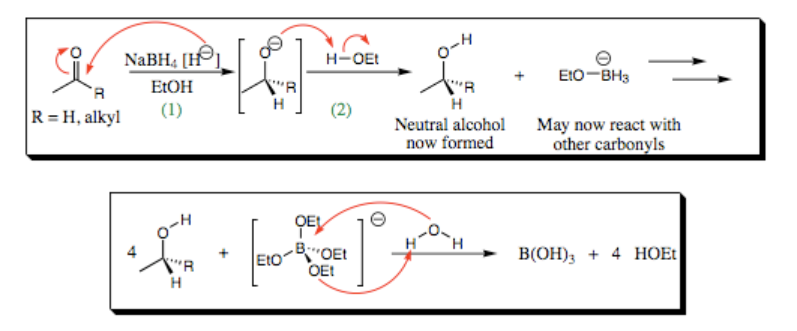BACKGROUND

This is the mechanism of the sodium borohydride reduction.
The article goes on to say why $\ce{NaBH4}$ is used:
Use of an alcohol as solvent does two things to help accelerate the $\ce{NaBH4}$ reduction.
- The protic solvent may hydrogen bond with the carbonyl oxygen, further polarizing the pi-bond, making it more receptive to nucleophilic attack by sodium borohydride.
- The solvent itself may attack the $\ce{BH3}$ formed after step (1) of the reaction, placing 4 groups on boron once again. Since the solvent is constantly surrounding the boron complex, attack of solvent on $\ce{BH3}$ will occur much more quickly than carbonyl attack as had to occur in an aprotic solvent. These two changes aid in increasing the kinetics of hydride addition using sodium borohydride a great deal!
[1]
This was relevant but did not answer the question, so basically 'naan thookiten' (I removed it)
Now also it is known that carbonyls love the electrophilic addition reaction.
Any polar compound like $\ce{LiCl, MgCl2}$ you give - it gets added very readily.

This picture here: it tells us how carbonyl groups are affected by Grignard reagents. Metal ions like $\ce{Li+, Mg^2+}$ make the carbonyl undergo this effect. The resulting adduct will make it prone to substitution and on hydrolysis, this adduct will lead to alcohol formation.
I can say that the same holds for protic solvents with $\ce{H+}$.
Principally solubility. Sodium borohydride is essentially insoluble in aprotic solvents. - Waylander
As Waylander rightly pointed out: Sodium borohydride is insoluble in aprotic solvents. Now we use its lithium counterpart (i.e., $\ce{LiAlH4}$). It is soluble in ether. The Al-H bond is much weaker, and thus, ionisation much easier [2].
Thus, $\ce{NaBH4}$ needs protic solvents (as it will budge and get ionised only then), while $\ce{LiAlH4}$ does not need them as it readily gets ionised.
Sources:
1 - https://healy.create.stedwards.edu/Chemistry/CHEM30/organicCD(Mitzel)/chapter6/pages7and8/page7and8.htm
2 - https://en.wikipedia.org/wiki/Lithium_aluminium_hydride#Use_in_organic_chemistry


